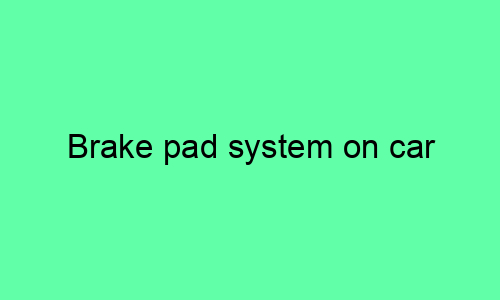Brake Pad System on Car
Introduction
The brake pad system is a critical component of a car’s braking system. It is responsible for converting the kinetic energy of the car into heat, which is then dissipated through the brake rotors. Brake pads are typically made of a composite material that includes metal, ceramic, and organic fibers. The type of material used depends on the desired performance characteristics of the brake pads.
Components of the Brake Pad System
The brake pad system consists of the following components:
- Brake pads
- Brake rotors
- Brake calipers
- Brake lines
- Brake fluid
Brake Pads
Brake pads are the primary friction material in the brake system. They are typically made of a composite material that includes metal, ceramic, and organic fibers. The type of material used depends on the desired performance characteristics of the brake pads.
Brake pads are designed to create friction between the brake rotors and the wheels. This friction converts the kinetic energy of the car into heat, which is then dissipated through the brake rotors.
Brake Rotors
Brake rotors are the metal discs that the brake pads press against to create friction. They are typically made of cast iron or steel.
Brake rotors are designed to dissipate heat quickly and efficiently. They are also designed to resist warping and cracking.
Brake Calipers
Brake calipers are the hydraulic devices that apply pressure to the brake pads. They are typically made of aluminum or cast iron.
Brake calipers are designed to provide the necessary force to overcome the friction between the brake pads and the brake rotors.
Brake Lines
Brake lines are the flexible hoses that carry brake fluid from the master cylinder to the brake calipers.
Brake lines are designed to withstand the high pressure of the brake fluid.
Brake Fluid
Brake fluid is a hydraulic fluid that transmits pressure from the master cylinder to the brake calipers.
Brake fluid is designed to withstand the high temperatures and pressures of the brake system.
How the Brake Pad System Works
When you apply pressure to the brake pedal, the master cylinder sends brake fluid to the brake calipers. The brake calipers then apply pressure to the brake pads, which press against the brake rotors. This creates friction, which converts the kinetic energy of the car into heat.
The heat is then dissipated through the brake rotors and into the surrounding air. This process slows down the car and eventually brings it to a stop.
Inspection and Maintenance of the Brake Pad System
It is important to inspect and maintain the brake pad system regularly. This will help to ensure that the system is functioning properly and that the brake pads are not worn out.
You should inspect the brake pads for wear and tear every time you change your oil. You should also have the brake system inspected by a qualified mechanic at least once a year.
Signs of Worn Brake Pads
There are a few signs that can indicate that your brake pads are worn out. These signs include:
- Squealing or grinding noises when you apply the brakes
- A decrease in braking performance
- A spongy or pulsating brake pedal
Replacing Brake Pads
If your brake pads are worn out, they will need to be replaced. You can replace brake pads yourself, but it is recommended that you have them replaced by a qualified mechanic.
To replace brake pads, you will need to:
- Remove the wheel
- Remove the brake caliper
- Remove the old brake pads
- Install the new brake pads
- Reinstall the brake caliper
- Reinstall the wheel
Conclusion
The brake pad system is a critical component of a car’s braking system. It is important to inspect and maintain the brake pad system regularly to ensure that it is functioning properly and that the brake pads are not worn out.






